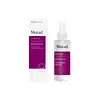What's inside
What's inside
 Key Ingredients
Key Ingredients

 Benefits
Benefits

 Concerns
Concerns

 Ingredients Side-by-side
Ingredients Side-by-side

Water
Skin ConditioningButylene Glycol
HumectantHamamelis Virginiana Water
AstringentUrea
BufferingYeast Amino Acids
HumectantTrehalose
HumectantInositol
HumectantTaurine
BufferingBetaine
HumectantChondrus Crispus Extract
Skin ConditioningPrunus Persica Fruit Extract
AbrasiveAnthemis Nobilis Flower Extract
MaskingSodium PCA
HumectantLecithin
EmollientTocopherol
AntioxidantMagnesium Ascorbyl Phosphate
AntioxidantVitis Vinifera Seed Extract
AntimicrobialGlycerin
HumectantCucumis Sativus Fruit Extract
EmollientPEG-12 Dimethicone
Skin ConditioningPEG-40 Hydrogenated Castor Oil
EmulsifyingSodium Citrate
BufferingDisodium EDTA
Phenoxyethanol
PreservativeCaprylyl Glycol
EmollientChlorphenesin
AntimicrobialSodium Benzoate
MaskingBenzyl Salicylate
PerfumingGeraniol
PerfumingLinalool
PerfumingCitronellol
PerfumingParfum
MaskingCI 15510
Cosmetic ColorantCI 14700
Cosmetic ColorantWater, Butylene Glycol, Hamamelis Virginiana Water, Urea, Yeast Amino Acids, Trehalose, Inositol, Taurine, Betaine, Chondrus Crispus Extract, Prunus Persica Fruit Extract, Anthemis Nobilis Flower Extract, Sodium PCA, Lecithin, Tocopherol, Magnesium Ascorbyl Phosphate, Vitis Vinifera Seed Extract, Glycerin, Cucumis Sativus Fruit Extract, PEG-12 Dimethicone, PEG-40 Hydrogenated Castor Oil, Sodium Citrate, Disodium EDTA, Phenoxyethanol, Caprylyl Glycol, Chlorphenesin, Sodium Benzoate, Benzyl Salicylate, Geraniol, Linalool, Citronellol, Parfum, CI 15510, CI 14700
Water
Skin ConditioningPolysorbate 20
EmulsifyingSalicylic Acid
MaskingGlycerin
HumectantHamamelis Virginiana Water
AstringentDipropylene Glycol
HumectantSalix Nigra Bark Extract
Skin ProtectingCarica Papaya Fruit Extract
Skin ConditioningChrysanthemum Parthenium Extract
Skin ConditioningAvena Sativa Kernel Extract
AbrasiveCamellia Sinensis Leaf Extract
AntimicrobialGlycyrrhiza Glabra Root
Skin ConditioningSodium PCA
HumectantLactic Acid
BufferingButylene Glycol
HumectantMaltodextrin
AbsorbentCitric Acid
BufferingPhenoxyethanol
PreservativeSodium Hydroxide
BufferingSodium Benzoate
MaskingPotassium Sorbate
PreservativeBenzoic Acid
MaskingTetrasodium EDTA
Water, Polysorbate 20, Salicylic Acid, Glycerin, Hamamelis Virginiana Water, Dipropylene Glycol, Salix Nigra Bark Extract, Carica Papaya Fruit Extract, Chrysanthemum Parthenium Extract, Avena Sativa Kernel Extract, Camellia Sinensis Leaf Extract, Glycyrrhiza Glabra Root, Sodium PCA, Lactic Acid, Butylene Glycol, Maltodextrin, Citric Acid, Phenoxyethanol, Sodium Hydroxide, Sodium Benzoate, Potassium Sorbate, Benzoic Acid, Tetrasodium EDTA
Ingredients Explained
These ingredients are found in both products.
Ingredients higher up in an ingredient list are typically present in a larger amount.
Butylene Glycol (or BG) is used within cosmetic products for a few different reasons:
Overall, Butylene Glycol is a safe and well-rounded ingredient that works well with other ingredients.
Though this ingredient works well with most skin types, some people with sensitive skin may experience a reaction such as allergic rashes, closed comedones, or itchiness.
Learn more about Butylene GlycolGlycerin is already naturally found in your skin. It helps moisturize and protect your skin.
A study from 2016 found glycerin to be more effective as a humectant than AHAs and hyaluronic acid.
As a humectant, it helps the skin stay hydrated by pulling moisture to your skin. The low molecular weight of glycerin allows it to pull moisture into the deeper layers of your skin.
Hydrated skin improves your skin barrier; Your skin barrier helps protect against irritants and bacteria.
Glycerin has also been found to have antimicrobial and antiviral properties. Due to these properties, glycerin is often used in wound and burn treatments.
In cosmetics, glycerin is usually derived from plants such as soybean or palm. However, it can also be sourced from animals, such as tallow or animal fat.
This ingredient is organic, colorless, odorless, and non-toxic.
Glycerin is the name for this ingredient in American English. British English uses Glycerol/Glycerine.
Learn more about GlycerinHamamelis Virginiana Water is made by distilling parts of the witch hazel plant. You can also call this ingredient "witch hazel water".
The name 'Hamamelis Virginiana Water' refers to the distillation product used in cosmetics. On the other hand, 'Witch Hazel' refers to the active drug ingredient.
Unless it is specified to be non-alcohol, many types of witch hazel ingredients are distilled in denatured alcohol.
Witch Hazel water is an astringent, anti-inflammatory antioxidant, and antibacterial ingredient.
It contains tannins. Tannins have a drying effect when used on skin by constricting proteins. The constriction also minimizes the appearance of pores.
Both the tannins and fragrance found in witch hazel may be skin-sensitizing.
Witch hazel water gets anti-inflammatory and antibacterial properties from its catechin and gallic acid content.
Indigenous groups have used witch hazel to help treat inflammation in North America for centuries.
Learn more about Hamamelis Virginiana WaterPhenoxyethanol is a preservative that has germicide, antimicrobial, and aromatic properties. Studies show that phenoxyethanol can prevent microbial growth. By itself, it has a scent that is similar to that of a rose.
It's often used in formulations along with Caprylyl Glycol to preserve the shelf life of products.
Sodium Benzoate is a preservative. It's used in both cosmetic and food products to inhibit the growth of mold and bacteria. It is typically produced synthetically.
Both the US FDA and EU Health Committee have approved the use of sodium benzoate. In the US, levels of 0.1% (of the total product) are allowed.
Sodium benzoate works as a preservative by inhibiting the growth of bacteria inside of cells. It prevents the cell from fermenting a type of sugar using an enzyme called phosphofructokinase.
It is the salt of benzoic acid. Foods containing sodium benzoate include soda, salad dressings, condiments, fruit juices, wines, and snack foods.
Studies for using ascorbic acid and sodium benzoate in cosmetics are lacking, especially in skincare routines with multiple steps.
We always recommend speaking with a professional, such as a dermatologist, if you have any concerns.
Learn more about Sodium BenzoateSodium PCA is the sodium salt of pyroglutamic acid. It is naturally occurring in our skin's natural moisturizing factors where it works to maintain hydration.
The PCA stands for pyrrolidone carboxylic acid, a natural amino acid derivative.
This ingredient has skin conditioning, anti-inflammatory, and humectant properties. Humectants help hydrate your skin by drawing moisture from the air. This helps keep your skin moisturized.
Learn more about Sodium PCAWater. It's the most common cosmetic ingredient of all. You'll usually see it at the top of ingredient lists, meaning that it makes up the largest part of the product.
So why is it so popular? Water most often acts as a solvent - this means that it helps dissolve other ingredients into the formulation.
You'll also recognize water as that liquid we all need to stay alive. If you see this, drink a glass of water. Stay hydrated!
Learn more about Water